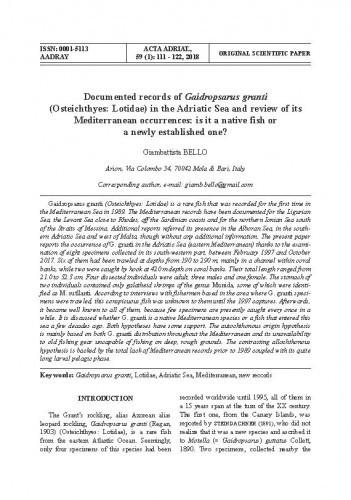Gaidropsarus granti (Osteichthyes: Lotidae) is a rare fish that was recorded for the first time in the Mediterranean Sea in 1989. The Mediterranean records have been documented for the Ligurian Sea, the Levant Sea close to Rhodes, off the Sardinian coasts and for the northern Ionian Sea south of the Straits of Messina. Additional reports referred its presence in the Alboran Sea, in the southern Adriatic Sea and west of Malta, though without any additional information. The present paper reports the occurrence of G. granti in the Adriatic Sea (eastern Mediterranean) thanks to the examination of eight specimens collected in its south-western part, between February 1997 and October 2017. Six of them had been trawled at depths from 190 to 290 m, mainly in a channel within coral banks, while two were caught by hook at 420 m depth on coral banks. Their total length ranged from 21.0 to 32.3 cm. Four dissected individuals were adult, three males and one female. The stomach of two individuals contained only galatheid shrimps of the genus Munida, some of which were identified as M. rutllanti. According to interviews with fishermen based in the area where G.granti specimens were trawled, this conspicuous fish was unknown to them until the 1997 captures. Afterwards, it became well known to all of them, because few specimens are presently caught every once in a while. It is discussed whether G. granti is a native Mediterranean species or a fish that entered this sea a few decades ago. Both hypotheses have some support. The autochthonous origin hypothesis is mainly based on both G. granti distribution throughout the Mediterranean and its unavailability to old fishing gear uncapable of fishing on deep, rough grounds. The contrasting allochthonous hypothesis is backed by the total lack of Mediterranean records prior to 1989 coupled with its quite long larval pelagic phase.; Gaidropsarus granti (Osteichthyes: Lotidae) je rijetka riba koja je prvi put zabilježena u Sredozemnom moru 1989. godine. Nalazi u Sredozemnom moru su dokumentirani za Ligursko more, Levantinsko more blizu Rodosa, s obale Sardinije i sjevernije Jonsko more južno od Messine. Dodatna izvješća ukazala su na njegovu prisutnost u Alboranskom moru, u južnom Jadranu i zapadno od Malte, iako bez ikakvih dodatnih informacija. U ovom radu prikazana je pojava G. granti u Jadranskom moru (istočni dio Sredozemnog mora) zahvaljujući ispitivanju osam uzoraka sakupljenih u jugozapadnom dijelu, u razdoblju između veljače 1997. i listopada 2017. godine. Šest primjeraka je ulovljeno na dubinama od 190 do 290 m, uglavnom u kanalu između koraljnih grebena, dok su dva uzorka uhvaćena udicom na dubini od 420 m na koraljnom grebenu. Njihova ukupna duljina kretala se od 21,0 do 32,3 cm. Četiri izdvojena primjerka su bila odrasle jedinke, tri mužjaka i jedna ženka. Želudci dvaju primjeraka su sadržavali samo rakove roda Munidae, od kojih su neki identificirani kao M. rutllanti. Sudeći po intervjuima s ribarima sa područja gdje su bili ulovljeni uzorci G. granti, ta lako prepoznatljiva riba bila je nepoznata do 1997. godine. Nakon toga, postala je uobičajena i prepoznata od strane ribara jer se od tada sporadično lovi. Vode se rasprave o tome da li je G. granti autohtona sredozemna vrsta ili novopridošla vrsta koja je tu dospjela prije nekoliko desetljeća. Obje hipoteze imaju uporište. Hipoteza o autohtonom podrijetlu uglavnom se temelji na zastupljenosti G. granti diljem Sredozemlja i relativne nedostupnosti starijim ribolovnim alatima neadekvatnim za ribolov na dubokim i grubim terenima. Oprečnu hipotezu podupire potpuni nedostatak nalaza u Sredozemnom moru prije 1989. godine zajedno s prilično dugom larvalnom pelagičkom fazom.
Sažetak

 Acta Adriatica : 59,1(2018) / glavni urednik Jakov Dulčić.
Acta Adriatica : 59,1(2018) / glavni urednik Jakov Dulčić.